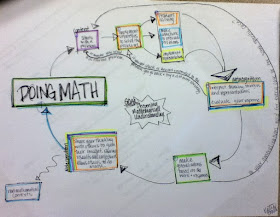Previously, we were introduced to the Doing Math Anchor Chart task (here). Then I shared a recent exemplar that used the metaphor of riding a bike to communicate the preservice teacher's vision of what it means to do mathematics. In this post, I will offer a teacher's more traditional concept map representation.
Chartists Statement
My
Anchor Chart is in the form of a cycle or a process because I see the act of
doing math as a cycle with the central goal of deepening our
understanding. When we do math we begin
with a problem that we want to solve. Using
prior knowledge and problem solving skills that we have developed (which could
include using representations) we work on the problem to get a response. We then must evaluate our response and
evaluate the process we took to get the response. If our method isn’t working or we don’t feel
our response is correct then we go back using this knowledge we gained to
implement a different strategy or to see if it’s possible we responded to a
different question. If we don’t need to
go back to rethink about our question or our problem solving method, we make
conjectures or generalizations about the responses we obtain. Many times we have questions about the
conjectures about whether or not they work for all cases. This gives us a new question that we may want
to explore. Regardless of exploring new
conjectures we somehow share our thinking and responses with other people to
gain their insight. Because we share our
responses, conjectures, and thought processes, we allow other people access to
these things so they can ask questions and do math themselves. In addition, the conjectures we develop may
allow us to make connections to problems in other contexts or we can use the
problem solving skills we developed in other aspects of life, so the cycle of
doing math is not closed, and because we go back and retry different problems
and form new questions based on the work we are doing the cycle does not go one
way.
Key
I choose to do develop my chart without specifically writing
down the Process Standards in any area because in my cycle of doing math,
different aspects of each standard are included in different steps of this
cycle. Here I will explain how the
different standards fit into the chart and where. (Note: the numbers correspond
to the labeled boxes):
1.
Communication: the problem we have to solve maybe to analyze
and evaluated someone else’s work.
Content: The problem we are working on is based on the content we want to
learn, for this unit that that would be Algebra.
2.
Problem Solving: The
problem that we have to solve requires that we implement a variety of
strategies that are appropriate to the context of the problem.
Reasoning and Proof: If our problem is to prove something then the
strategies we implement will be the different methods of proofs and determining
which proof method is most appropriate for the problem presented.
3.
Problem Solving:
Implement a variety or strategies determining which one will work best as we
work towards a response.
Connections: Recognize
similarities between the problem that’s presented and previous problems we have
solved.
Representations: Use
representations to help you think about a problem and translate between the
representations to help solve problems.
4.
Problem Solving:
Reflect on the strategy we used. Did the
process we used allow us to effectively find a response?
Connections: Think about
how the problem we are solving connects to and builds on other mathematical
ideas.
Representations: Use
representations as a way to organize our thinking. Look back that the ones we used when solving
problems and think about how they helped us.
Metacognition: interpreting our response and strategies require that we reflect
on our process and how we thought about the problem.
5.
Reasoning and Proof: Make conjectures about the response we
obtained, this may occur though connecting
our work with previous work we have done.
6.
Problem Solving: It’s
possible that the knowledge we gained and would like to share is the skills we
used to solve the problem.
Reasoning and Proof: We
can share a conjecture that we have developed or we can share our thinking in
the form of a proof.
Communication: Clearly
expressing the response and the process to others either formally through
writing, possibly a formal proof (Reasoning
and Proof), or through discussion with others.
Connections: It is
possible that we use examples and make connections to other problems to help
our audience understand what we are communicating.
Representations: Maybe
we choose to organize our thinking into some form of representation as way to
communicate our thinking with others.
Metacognition: We may decide to share our thinking process; inorder to do this
we must think about our own thinking.
7.
Reasoning and Proof:
Throughout the entire process of doing math, we are building an argument.
Connections: We build on
the knowledge we gained in order to solve problems in the future.
8.
Connections: We can apply the knowledge we built
through this process to contexts outside of math.

No comments:
Post a Comment